Oil will never run out, we all know that. Just see: 40 years ago we were supposed to have only “40 years of oil” left, and here we are, 40 years later with still “40 years of oil” of reserves, or almost. Even though this statement is misleading, it supports the idea that there will always be plenty of oil, and from there that oil production cannot peak. It’s obvious, my dear Watson: if oil can peak, then it is possible that we partially run out of oil, which the fact deemed impossible by many.
Actually, oil production must peak. It is the case for any single field, and it is also the case for the world. It results from a maths theorem that states that the annual extraction of any stock given once and for all (and therefore which is not renewed at any time) can only start from zero, go through a maximum, then tend to zero again. This conclusion is of course also valid for a country, that has an endowment of oil given once and for all, even if it is zero ! So the oil production of any country can only rise, peak, and decline. This conclusion is so robust that… a number of countries have already passed their production peak. Follow the guide !
NB: figures below include conventional and non conventional oil.
Europe
In Europe, all producing countries are in decline (post peak), except Italy maybe. To have a basis for comparison with the figures below, France uses roughly 1,9 million barrels daily (or 260.000 tonnes, that is a big tanker every day).

Oil production of Denmark peaked in 2004.
Source : BP Statistical Review, 2015
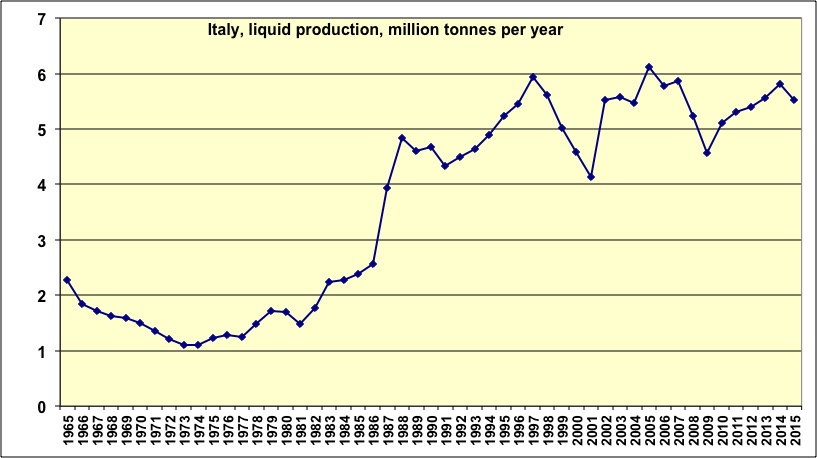
Oil production of Italy peaked – so far – in 2005.
Source: BP Statistical Review, 2015
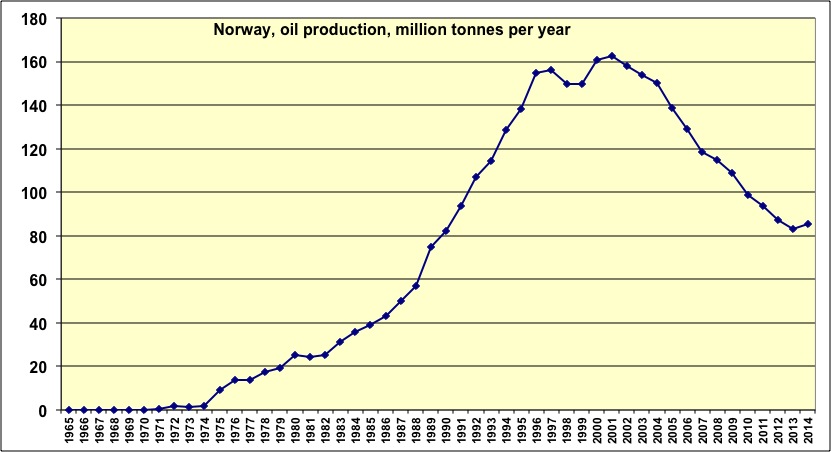
Oil production of Norway (first producer in Western Europe) peaked in 2001.
Source : BP Statistical Review, 2015
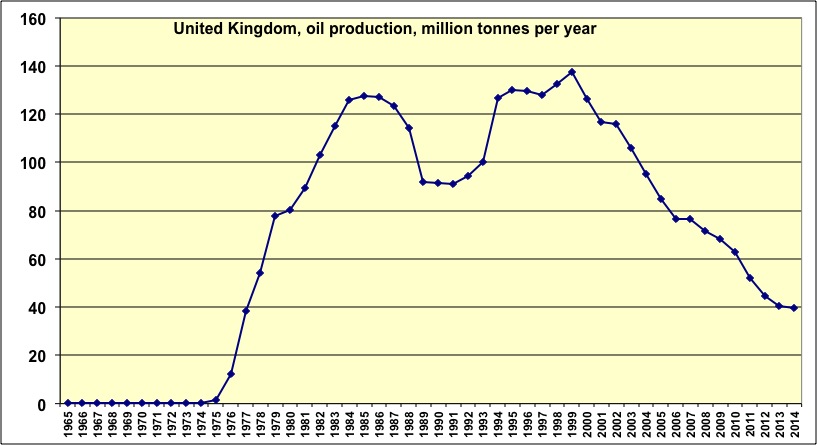
Oil production of UK (second producer in Western Europe) peaked in 1999.
Source : BP Statistical Review, 2015
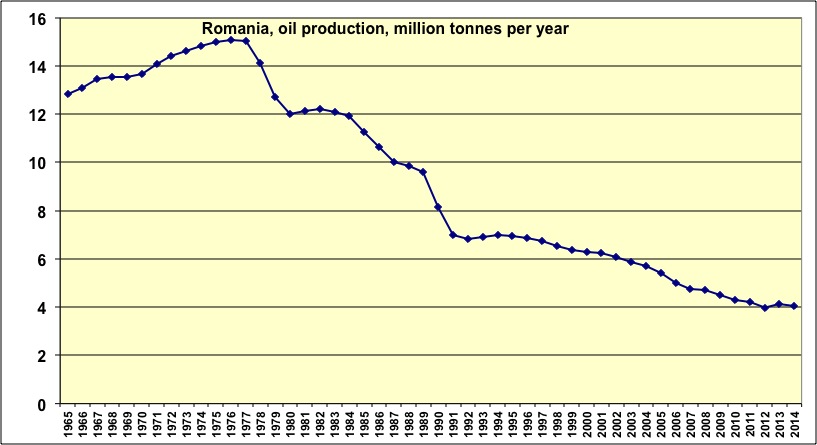
Oil production of Roumania peaked in 1977.
Source : BP Statistical Review, 2015
Globally, oil production in Europe is in sharp decline. Western Europe (European Union + Norway) produces less than 30% of its consumption.

Oil production of Western Europe (UE+Norway) peaked in 2000.
Source : BP Statistical Review, 2015
Former USSR
Russia, which is the second oil producer in the world, has probably passed it “true” peak in the 1980’s, but its production is presently rising to a secondary maximum. A number of minor oil producing countries of the zone are post peak.
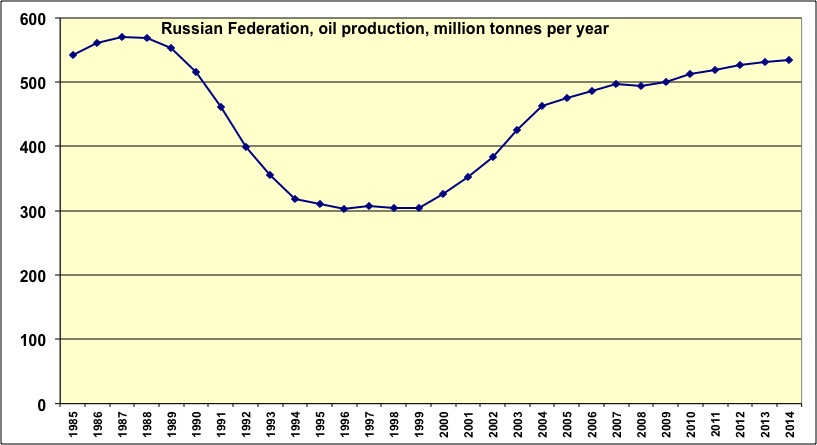
Oil production of Russia.
The true peak probably happened in 1987, and the production is heading for a secondary one.
Source : BP Statistical Review, 2015
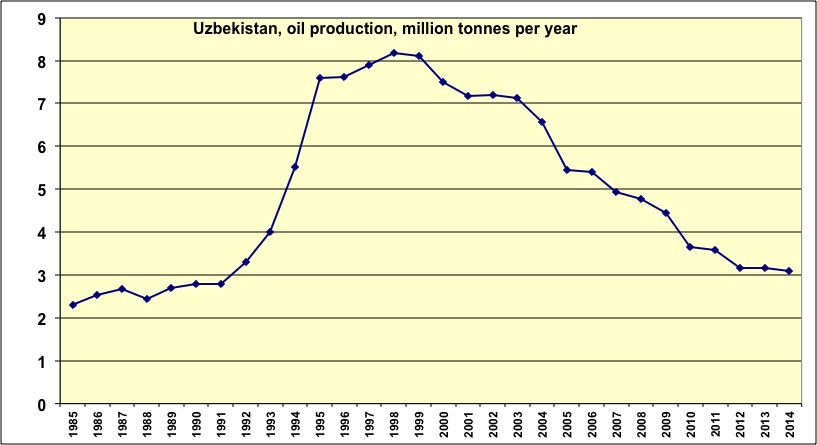
Oil production of Uzbekistan peaked in 1999.
Source : BP Statistical Review, 2015
Globally, the oil production of the full zone is still rising.

Oil production of Former USSR (Apart from Russia, the main producers are Kazakhstan and Azerbaïdjan).
The main peak has not happened yet.
Source : BP Statistical Review, 2015
Far East
The main producer of the Far East is China, that has a rising production for the time being. But the second (Indonesia) is in decline, and India, that comes third, is globally on a plateau since 1995. A number of significant producers of the zone arepost peak.

Oil production of Australia peaked in 2000.
Source : BP Statistical Review, 2015
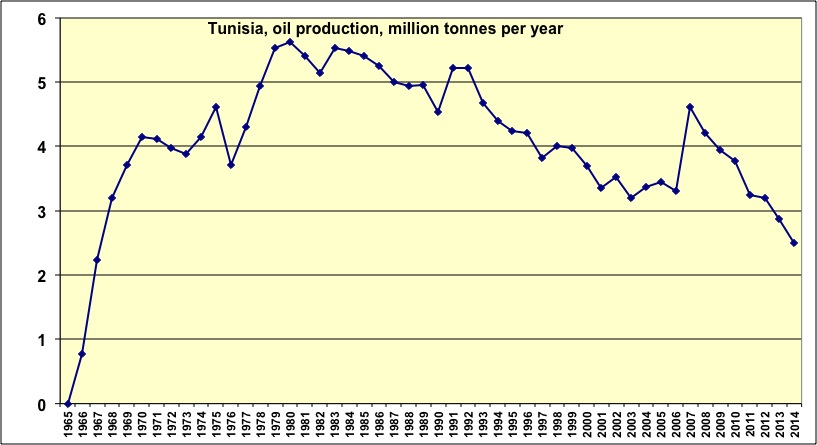
Oil production of Brunei peaked in 1979 (the Sultan of Brunei was one of the richest men of the planet at a time).
Source : BP Statistical Review, 2015
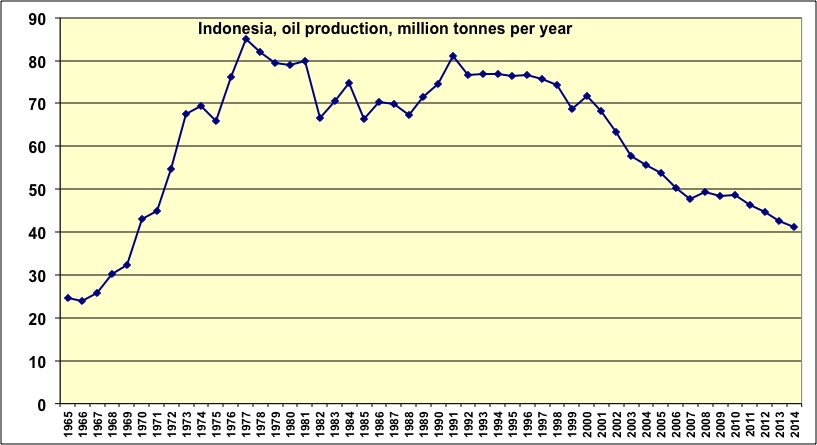
Oil production of Indonesia peaked in 1977, with a secondary peak in 1991.
Source : BP Statistical Review, 2013

Oil production of Malaysia. Did it peak in 2004?
Source : BP Statistical Review, 2015

Oil production of Viet-Nam. Did it peak in 2004?
Source : BP Statistical Review, 2015
Globally, the production of the zone is following a slightly ascending plateau.
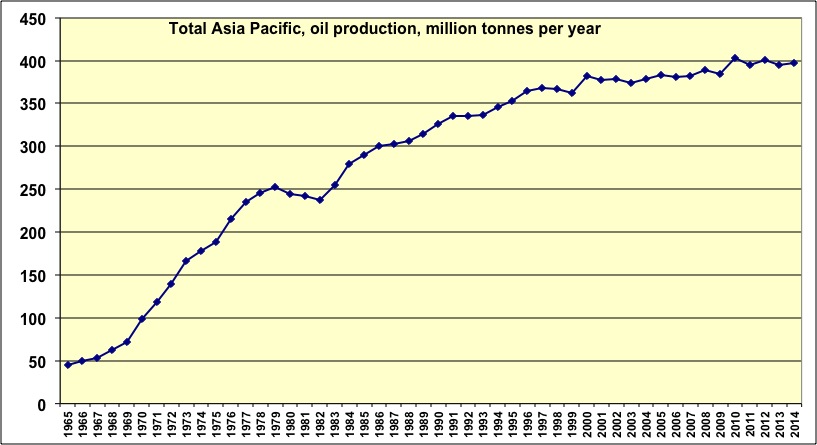
Oil production in Asia is following a slightly ascending plateau since 2000, because China (half of the zone, with roughly 4 million parrels per day) is still rising.
Source : BP Statistical Review, 2015
Middle East
The Middle East, “oil wonderland” in everybody”s mind, yields some surprises: more than one country is post peak…
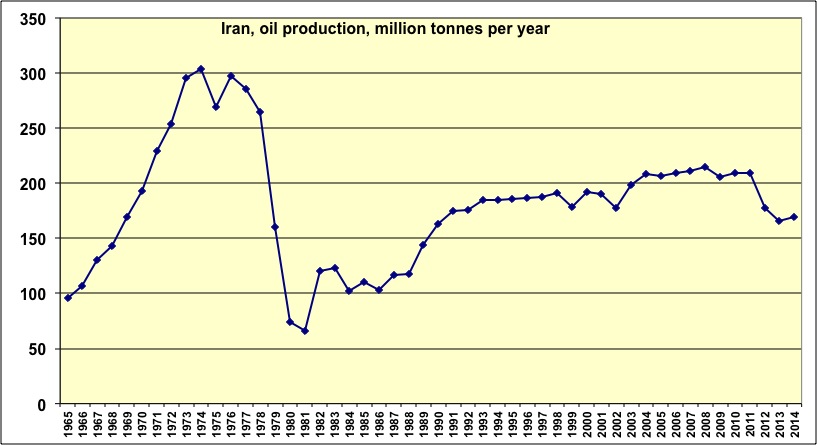
Oil production in Iran probably went through its main peak in 1974, even though a secondary peak is still ahead.
Source : BP Statistical Review, 2015
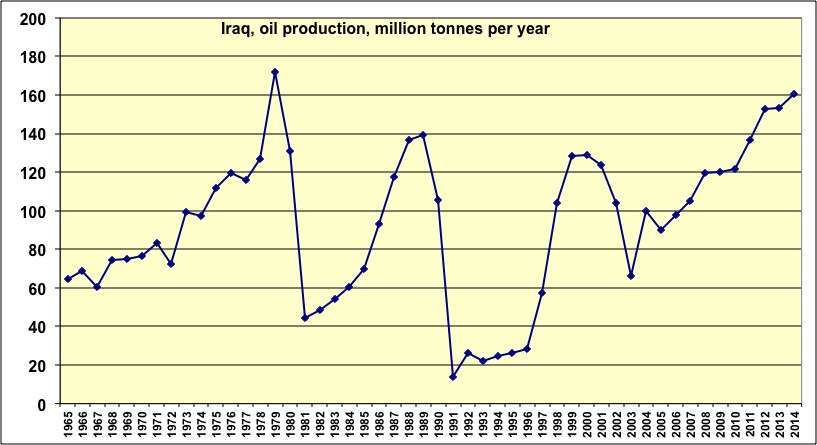
Oil production in Iraq.
A historical peak has happened in 1979, after the second oil shock, but the very volatile level of production makes it hard to have a definite conclusion ! A number of geologists consider that in a context of investments with no obstacles the production could go up tu 6 or 7 million barrels per day, but the local context makes it unsure whether this will be the case.
Source : BP Statistical Review, 2015
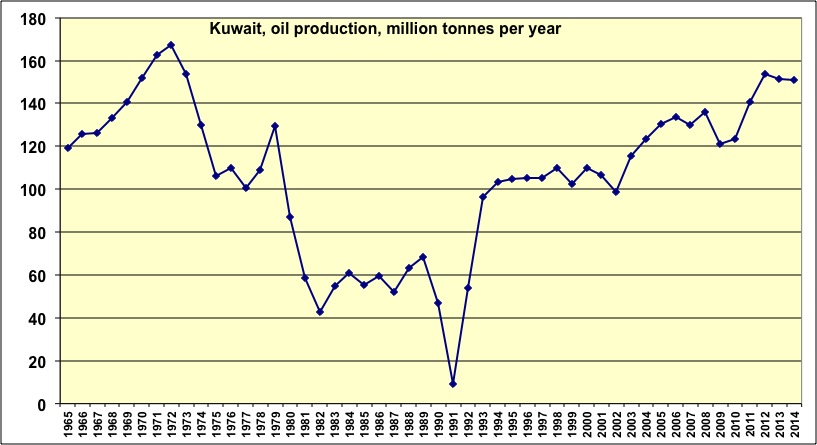
Oil production in Kuwait has possibly peaked in 1972 (the sharp decrease in 1991 is of course the consequence of the invasion by Iraq, but it took only 2 years to get back to the previous situation).
The production probably heads towards a plateau that will be at the same level.
Source : BP Statistical Review, 2015
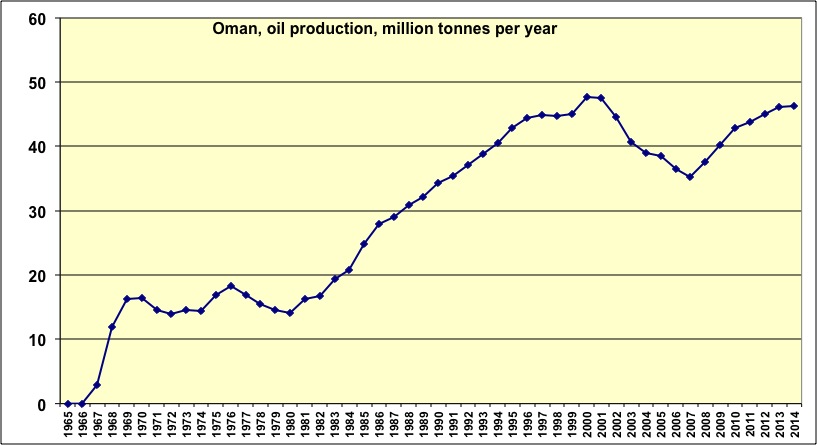
Oil production of Oman. Has it peaked in 2001?
Source : BP Statistical Review, 2015
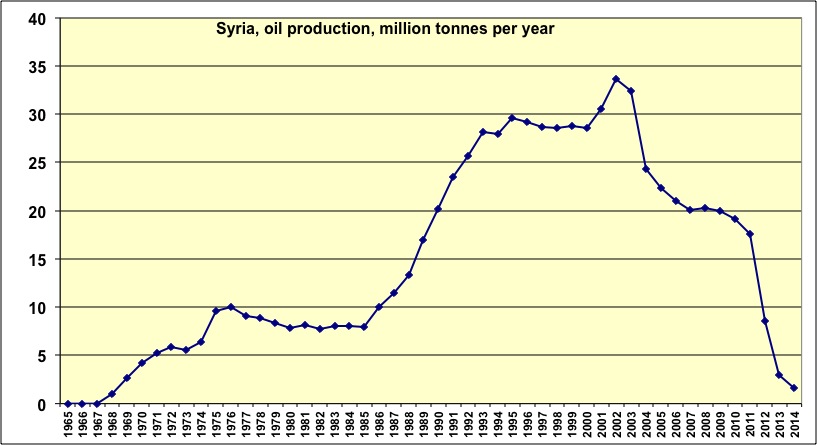
Oil production of Syria peaked in 2002.
Source : BP Statistical Review, 2015
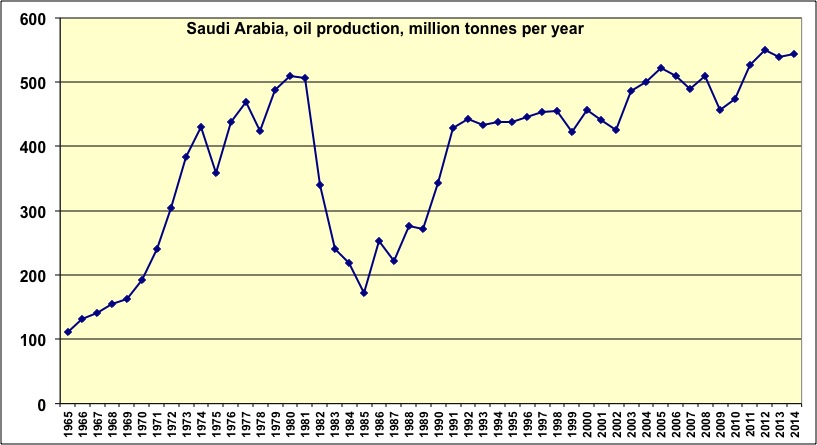
Oil production of Saudi Arabia, first oil producer in the world, along with Russia. Ascending plateau for the time being.
Source : BP Statistical Review, 2015
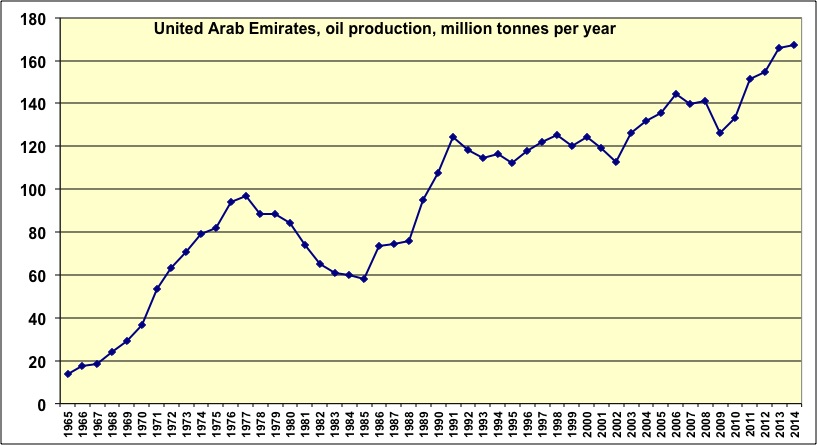
Oil production of the Emirates. 3 “false peaks” since 1975!
Source : BP Statistical Review, 2015
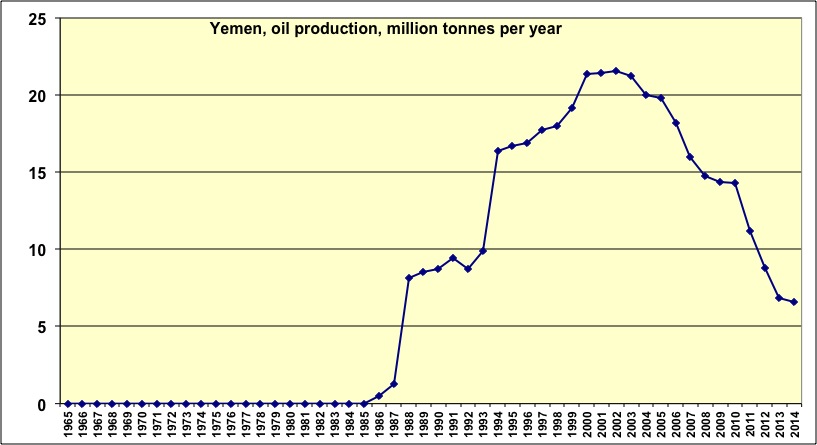
Oil production in Yemen peaked in 2002.
Source: BP Statistical Review, 2015
Overall the zone is still having a rising production, and could keep a level close to the present value for 30 years at least.
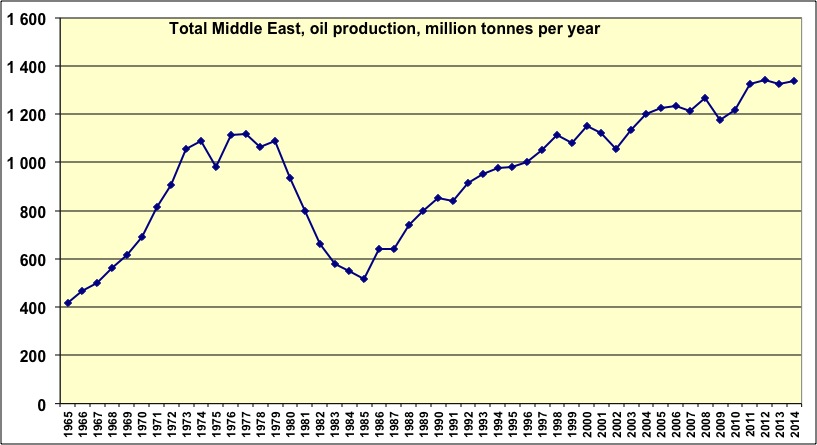
Oil production in the Middle East.
Source : BP Statistical Review, 2015
Afrique
In this zone, where oil production is globally rising, some countries are post peak already.
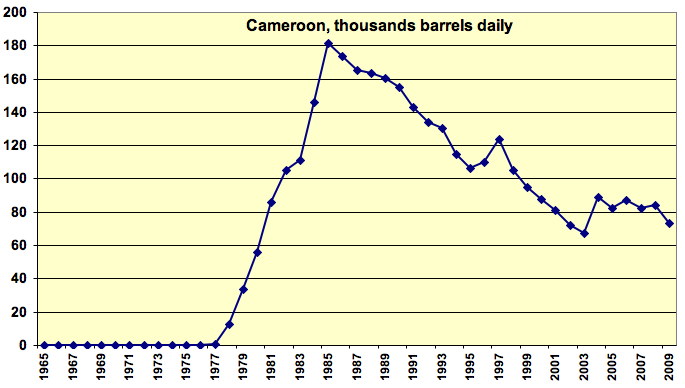
Oil production of Cameroon peaked in 1985.
Source : BP Statistical Review, 2010

Oil production of Algeria. Peak in 2008?
Source : BP Statistical Review, 2015
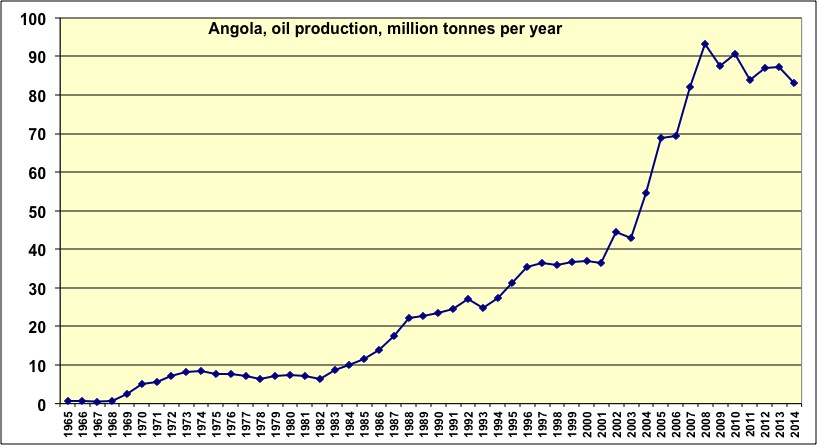
Oil production of Angola. Peak in 2008?
Source : BP Statistical Review, 2015
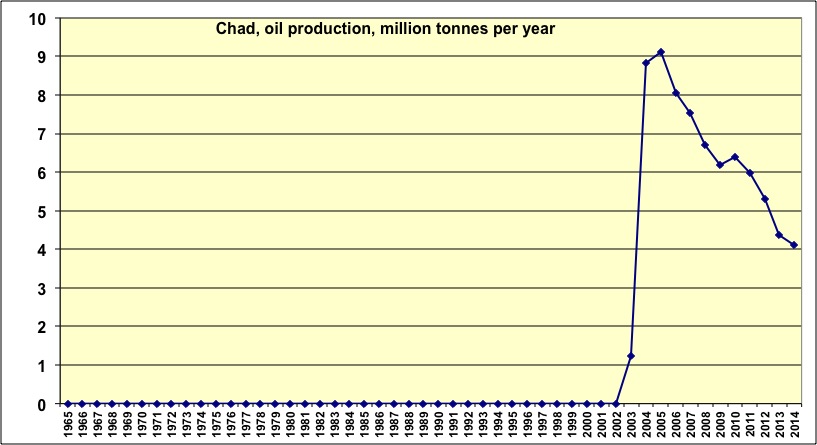
Oil production of Chad. Peak in 2005?
Source : BP Statistical Review, 2015
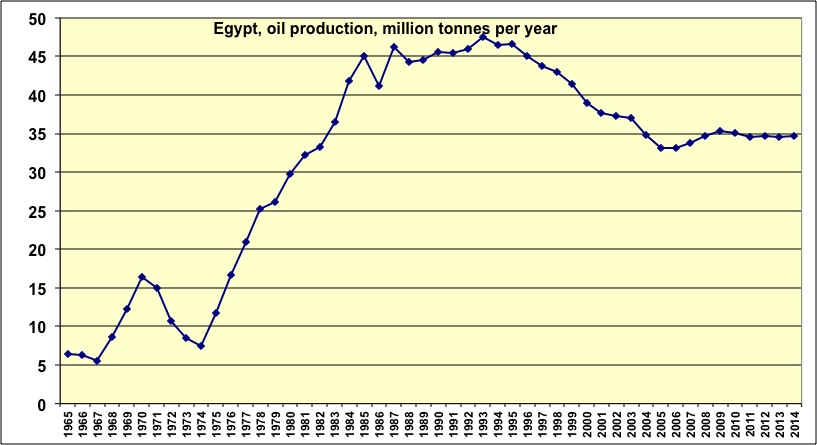
Oil production of Egypt peaked in 1993.
Source : BP Statistical Review, 2015
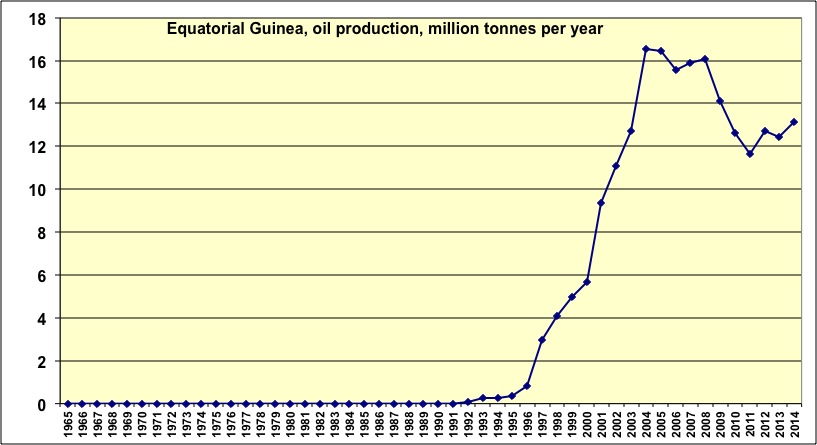
Oil production of Equatorial Guinea peaked in 2005.
Source : BP Statistical Review, 2015
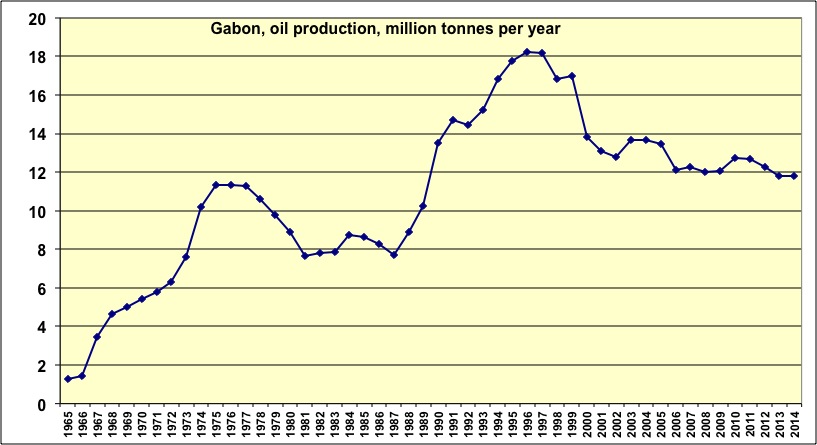
Oil production of Gabon peaked in 1996.
Source : BP Statistical Review, 2015
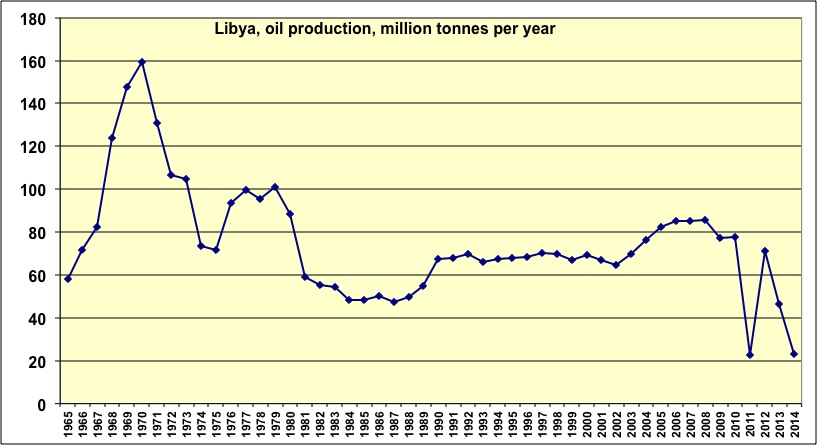
Oil production of Libya peaked in 1970.
Years since 2011 are not significant because of the war.
Source : BP Statistical Review, 2015

Oil production of Tunisia peaked in 1980.
Source : BP Statistical Review, 2015
Overall, African oil production seems to be on a decline.
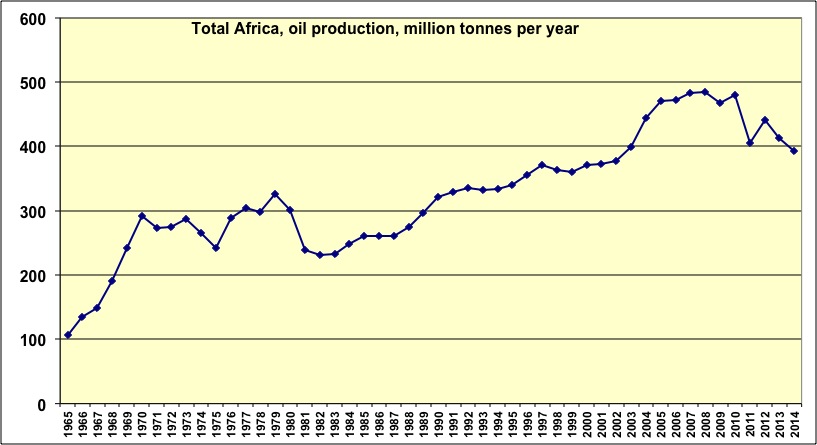
Oil production of Africa.
It probably peaked in 2008, because even a recovery of Libya to 70 million tonnes per year wouldn’t bring back the 2008 production.
Source : BP Statistical Review, 2015
Southern America
Many producers of this zone (Mexico is in the Northern American zone) have peaked.
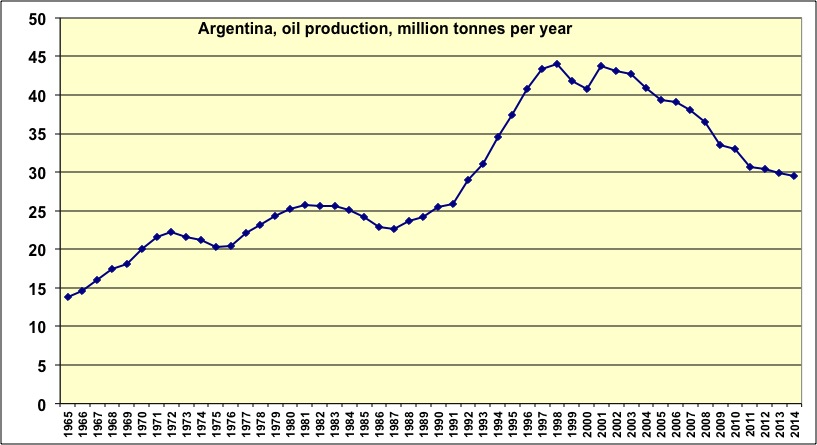
Oil production of Argentina peaked in 1998.
Source : BP Statistical Review, 2015

Oil production of Peru peaked in 1982.
Source : BP Statistical Review, 2015

Oil production of Trinidad & Tobago peaked in 1978.
Source : BP Statistical Review, 2015
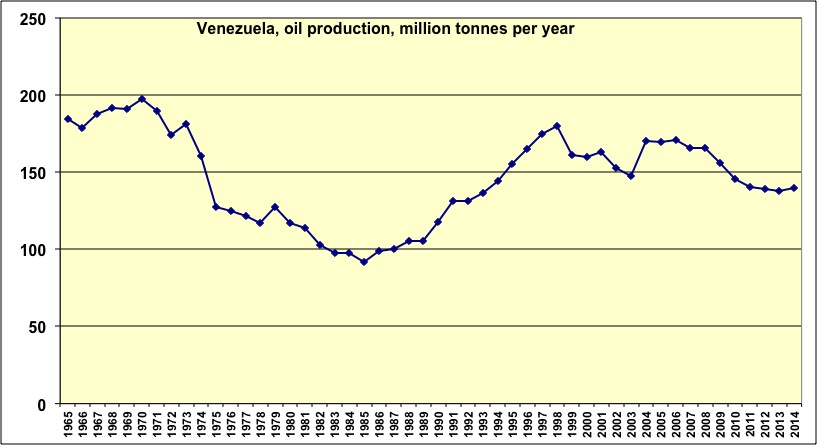
Conventional oil production of Venzuela peaked in 1970.
However, the country claims 100 billion barrels of proven reserves of extra-heavy oil, that could sustain a production of 3 million barrels per day for one century. Will it lead to a very long plateau below the 1970 peak, or above?
Source : BP Statistical Review, 2015
As a result, the zone is globally on a rising plateau, that could last – with ups and downs – something like two decades.
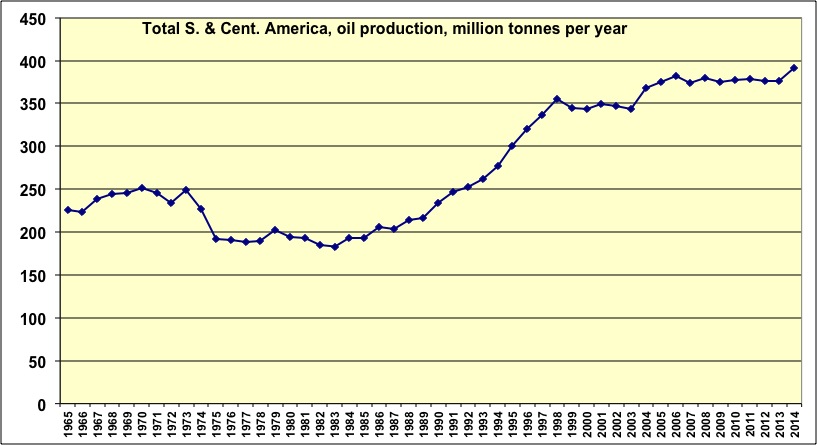
Oil production of Southern America.
Source : BP Statistical Review, 2015
Northern America
This zone has only three countries.
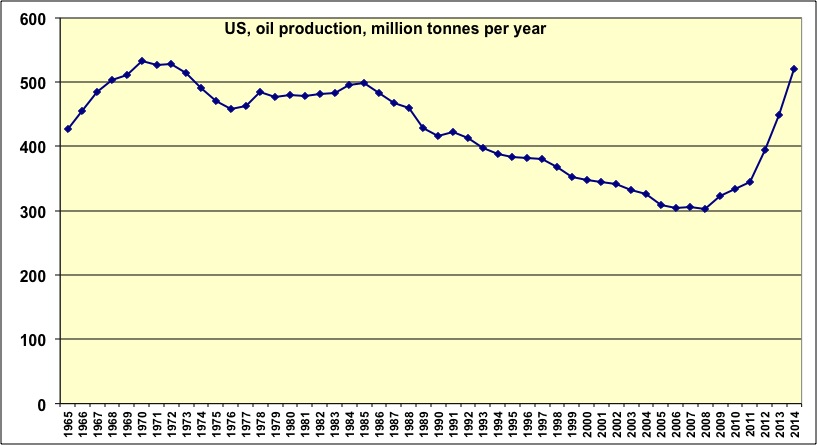
Oil production of the US peaked in 1970 for the time being.
The recent rebound includes natural gas liquids (about 50 million tonnes in 2014), which is not really oil, and is due to the increase of non conventional gas.
Source : BP Statistical Review, 2015
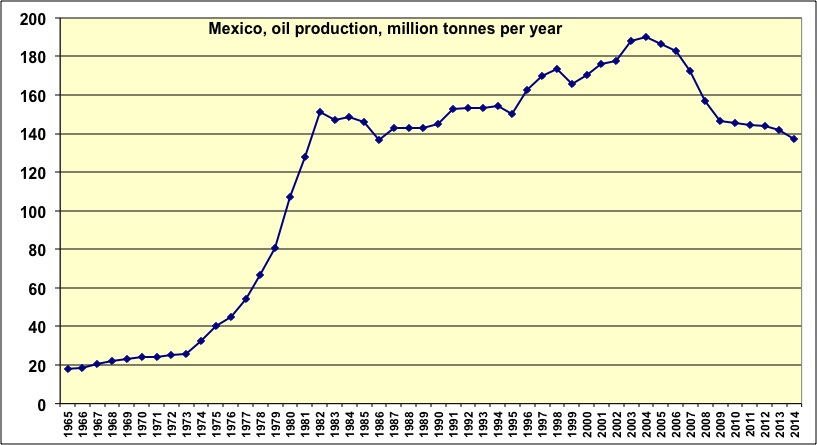
Oil production of Mexico peaked in 2004, most probably.
Source : BP Statistical Review, 2015
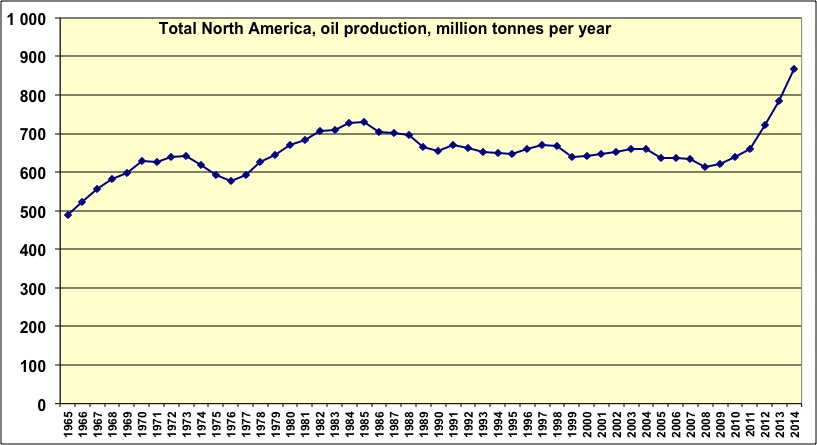
Oil production of Northern America.
A first peak happened in 1985, followed by a long descending plateau, and now a rise towards a second maximum.
Source : BP Statistical Review, 2015
World
So, is a production peak just a bad joke ? Actually, even for the world as a whole, it turns out that the peak for conventional oil could be… now. When adding natural gas liquids and non conventional oil, the global output is still slowly rising,
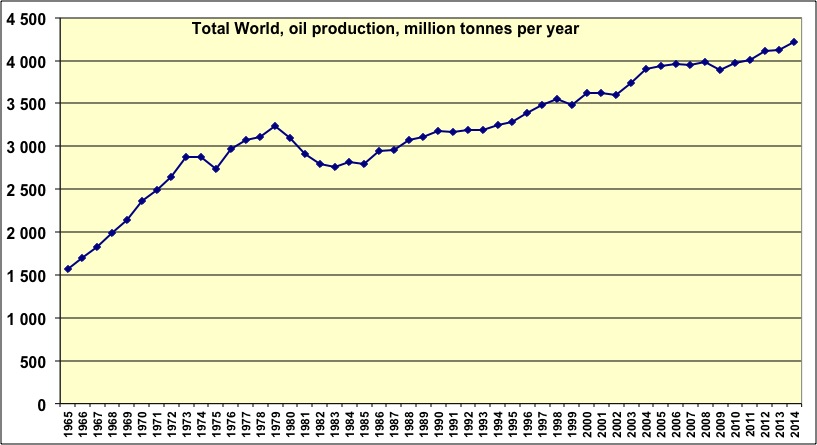
World oil production since 1965.
Chances are that we are on a kind of slightly ascending plateau, before the beginning of a marked decline, to which we will have to adapt !
Source : BP Statistical Review, 2015.